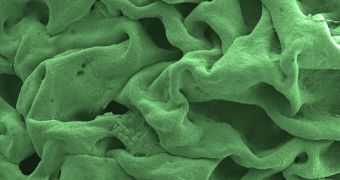Certain types of bacteria were found to be able to produce biofilms that are significantly more efficient at repelling water than Teflon is. This is the same material used to make non-sticky pans.
According to a new study, it would appear that these biofilms, belonging to only a few species of microorganisms, are the most efficient water-repellent materials in nature, a lot more so than the cover on the leafs of the lotus plant.
In essence, biofilms are nothing more than mat-like structured created from bacteria. They can occur nearly everywhere, including in the human body. In fact, some bacterial infections are so dangerous precisely because the organisms infecting that person produce biofilms.
These structures have a very clear role, and that is to protect the colony underneath at all costs. This is why the biofilm is so hard to pierce, completely impermeable to water, Wired reports.
“There are a few man-made materials that can perform better, and they have to be made in clean rooms. They’re incredibly expensive and brittle. Making biofilm is as easy as growing bacteria,” says expert Alexander Epstein.
The investigator, who was a member of the team that conducted the new research, holds an appointment as a materials scientist at the Harvard University. He is also the coauthor of a new study detailing the full results of the investigation.
The paper was published in the January 18 issue of the esteemed journal Proceedings of the National Academy of Sciences (PNAS). Investigators mostly focused on the Bacillus subtilis bacteria.
In addition to repelling water, this microorganism also rejects acetone, concentrated alcohol, and even liquids that are vaporized onto its biofilm. These are some amazing properties, researchers admit.
“We started to put different liquids on it. Concentrated alcohols just rolled right off. We found the biofilms substantially superior to Teflon,” the researcher adds.
“We’re realizing more and more that almost all bacteria in nature are found as biofilms. It offers a lot of advantages for them, including better protection and increased chances they’ll stick to sources of food. It’s crazy stuff,” Epstein explains.
He adds that a biofilm takes shape when bacteria in a community joint their bodies together by using a mixture of proteins and special sugars. The result is a structure called the extracellular matrix.
“We don’t know much about it, but it’s broadly true that you need both protein and sugars to have working biofilm. Sugars absolutely have to be there, but we don’t know why. We’re doing some followup research on that now,” the expert concludes.

 14 DAY TRIAL //
14 DAY TRIAL //